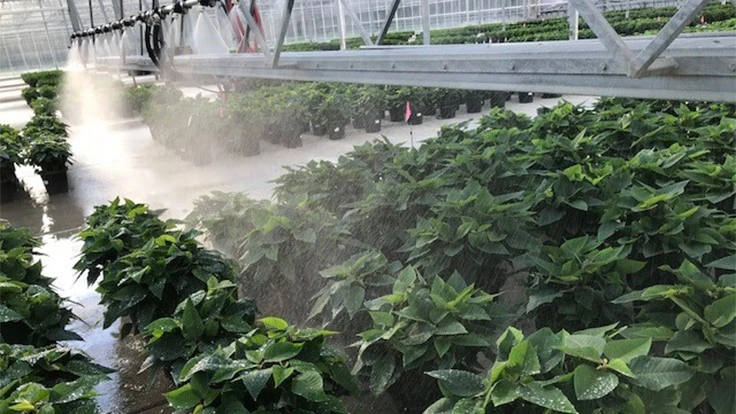

For many growers, poinsettia production is a must. But the plants can stretch too tall and become infested with whiteflies, so having solutions to those problems is also necessary. Working with SePRO, growers have found methods to move past these issues.
Evading whitefly issues
Casa Verde Growers is a 35-acre facility with 24 acres under cover in Columbia Station, Ohio. Within the covered space, section grower Jen DeVere manages five acres, of which four acres is dedicated to poinsettia production. This encompasses all of the operation’s production of the crop.
In early September, in Week 36, DeVere noticed some whiteflies on her poinsettias — more than she had seen in past years. “In a two-acre area, I had eight sticky cards out, which is a little low, but I just did one per bay,” DeVere says. “I was averaging between six and 10 whiteflies at one point. I’m like, ‘Okay, that’s enough.’”
DeVere applied Rycar® Insecticide, a translaminar insecticide — meaning it is absorbed into the leaf providing protection to both top and underside of the leaf — from SePRO. She applied it using an automated boom system and quickly started seeing results. “I can spray with [the booms], and translaminar chemicals are super for that because I can set up a boom to jog down and jog back and do a real quick light glaze of spray,” she says. “It frees me up to do other things.”
However, boom irrigation isn’t the only way to apply Rycar. Ian Patric, head grower at Smith Gardens’ Aurora, Oregon, facility, uses a fogger on Q-biotype whiteflies. He relies on the product as a cleanup around late October after using biocontrols as a preventative measure at the facility, which has about 25 acres of undercover production space and roughly 10 acres of outdoor space.
“I think [the fogger] provides better coverage — especially when you have a tight crop with a closed canopy,” Patric says. “Also, the application time is significantly less with a fogger, compared to spraying.”
Rycar is a noted tool for growers especially during poinsettia season. It is compatible with biocontrol agents and has good crop safety on poinsettias including bracts in color.

Fessler Nursery in Woodburn, Oregon, is about 12 miles south of Aurora, and has approximately 300,000 square feet of covered greenhouses. Head grower Taylor Burk also applies Rycar to control problematic whiteflies. “It did a really nice job knocking everything down,” she says.
Controlling poinsettia growth
Topflor®, a plant growth regulator (PGR) from SePRO, has helped these growers improve their overall crop production as well. Burk drenched 0.5 ppm of Topflor on one poinsettia variety in the second-to-last week of October last year as an “emergency drench.” “They stayed right where they were in size and colored up nicely,” she says. “There was no delay in bract coloring, and it strengthened the stems a little bit.”
Burk also uses Topflor on gardenias, and she says she aims to start a trial program this year using it on poinsettias.
Smith Gardens’ Patric says he has used Topflor on hydrangea. “We’re liking it on hydrangea,” he says.
At Casa Verde Growers, DeVere says she has almost exclusively used Topflor as a PGR so far in 2018, whether it was sprays, toning throughout production, sprenching or drenches at light rates. “The fact that I love most about Topflor is that it doesn’t lock up flower buds, and it doesn’t impact lateral branching,” she says.
DeVere plans to apply 0.25 or 0.5 ppm of Topflor on poinsettia crops in the beginning of October. “With the experiments that I had tried last year with Topflor, I didn’t see a reduction of bract size, which was great,” she says. “I did see them slow down a little bit, but I did a later drench, and this year I want to do an earlier drench with Topflor to manage some of my more aggressive varieties.”

Explore the October 2018 Issue
Check out more from this issue and find your next story to read.
Latest from Greenhouse Management
- 2025 Proven Winners Horticulture Scholarship applications now open
- How to improve inventory and shipping management in the greenhouse
- Leading Women of Horticulture: Anna Ball, Ball Hort, and Terri McEnaney, Bailey Nurseries
- GM CEA HERB Part 2: A guide to increasing the sowing density of culinary herbs
- GM CEA HERB Part 1: Best practices for producing culinary herbs in controlled environments
- USDA fires experts on invasive pests, including Asian citrus psyllid, chilli thrips
- CEA Alliance celebrates bipartisan introduction of Supporting Innovation in Agriculture Act
- Dümmen Orange North America celebrating 25th anniversary in 2025





